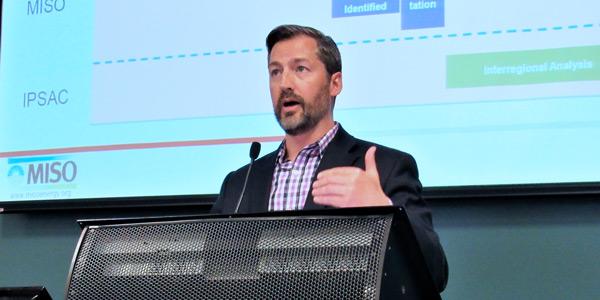By Amanda Durish Cook
Officials remain optimistic about MISO’s interregional transmission planning process with SPP despite its failure to produce a single project even after producing two coordinated studies since 2014.
MISO recently declined to approve a South Dakota transmission project that would have traversed both RTOs, the only potential feasible project to come out of the latest coordinated study that wrapped up this year.
Staff last month told MISO’s Planning Advisory Committee in mid-August that it no longer recommended the $5.2 million, 115-kV Split Rock-Lawrence circuit project in South Dakota, which would have been the RTOs’ first-ever interregional project. Staff instead recommended following an updated operating guide from line owner Xcel Energy and operating the Lawrence–Sioux Falls line in an open circuit to shift some congestion to the nearby Sioux Falls–Split Rock 230-kV line. (See SPP Glum as MISO Axes Last Interregional Project.)
During MISO Board Week in September, Vice President of System Planning Jennifer Curran said she thought the RTOs’ interregional process worked as intended because MISO’s regional review identified a “cheaper option” than a costly interregional project.
MISO has vowed to continue interregional communication and planning with SPP.
“MISO continues to work aggressively to try to identify cost-effective interregional projects to help ensure a robust transmission network that can mutually benefit our members,” MISO Manager of Interregional Planning Eric Thoms told RTO Insider. “In this recent case, the interregional process was successful in finding an appropriate solution to meet the need. In this case, a superior regional solution was identified after additional analysis.”
Communication Breakdown?
MISO shared its decision with SPP “in advance of the Aug. 16 Planning Advisory Committee,” Thoms said, adding that planning staff from both RTOs participated in a joint conference call in early August to discuss the information.
“We are committed to communicating study results with our partners as soon as appropriate,” Thoms said.
SPP COO Carl Monroe last month told RTO Insider that his RTO only discovered MISO’s decision through posted meeting materials and news coverage. Monroe has since walked back the comments.
“I regret misstating that SPP was unaware of MISO’s intent not to recommend the project for construction and have spoken with Mr. Thoms directly to acknowledge the error,” Monroe said. “We’re pleased with MISO’s expressed commitment to improving coordination between our organizations, and SPP likewise will do everything in our power to support interregional coordination in the interest of greater reliability and affordability across our industry.”
Thoms said the RTOs’ latest coordinated study was not conducted in vain, as MISO discovered “differences in operations and transmission service treatment that [may] arise as a potential barrier to future interregional projects.” He said MISO and SPP plan to work to better align the unnamed differences and added that they ultimately did not affect the chances of the South Dakota project proposal.
According to Thoms, MISO reached out to SPP during the coordinated study process more frequently than is required by their joint operating agreement, which outlines the procedures for interregional coordination. The JOA stipulates that the Joint Planning Committee, comprising staff of both RTOs, must meet no less than twice per year.
In addition, MISO and SPP corresponded “numerous” times during the year to discuss interregional stakeholder meetings and study data, modeling and results, Thoms said. He added that the coordinated system plan itself requires supplementary meetings to update and finalize the study.
‘Work in Progress’
MISO may still have ideas about how to improve communication with SPP regarding interregional planning, although Thoms is holding those cards close to his chest. In 2016, rather than embark on another coordinated system study, MISO suggested that the RTOs spend the year improving the study process, advice that it eventually abandoned.
“MISO and SPP continue discussions around a long-term coordination effort. At this time, those details are still being developed,” Thoms said.
He added that MISO staff are committed to “working with SPP and other stakeholders to foster effective communication and mutual understanding around these projects.”
Missouri Public Service Commission economist Adam McKinnie hails from a seams-heavy state and is often a vocal critic of the RTOs’ inability to produce interregional projects. While he declined to comment on how communication procedures between MISO and SPP could be improved, he did say there is benefit to the RTOs working together and identifying interregional projects.
“We’ve been trying to do this for years,” MISO Board of Directors Chairman Michael Curran said of interregional projects at a Sept. 21 meeting. “It has been a long struggle, and you can only do so much when your neighbor isn’t willing to coordinate, but that coordination is starting.
“Only good things can happen from here,” he told MISO stakeholders. “We’re on our way to an intermarket system, but don’t get too excited just yet — it’s a work in progress.”





